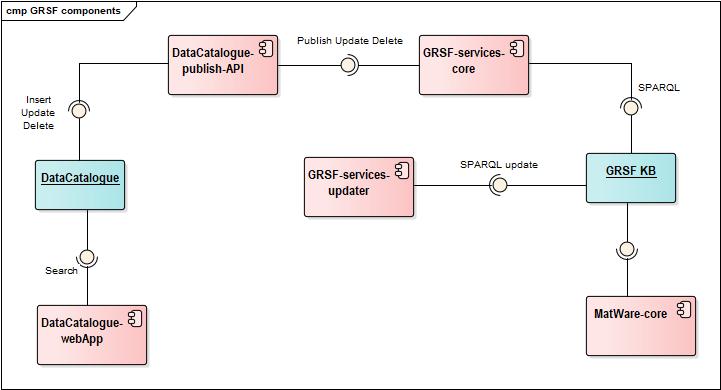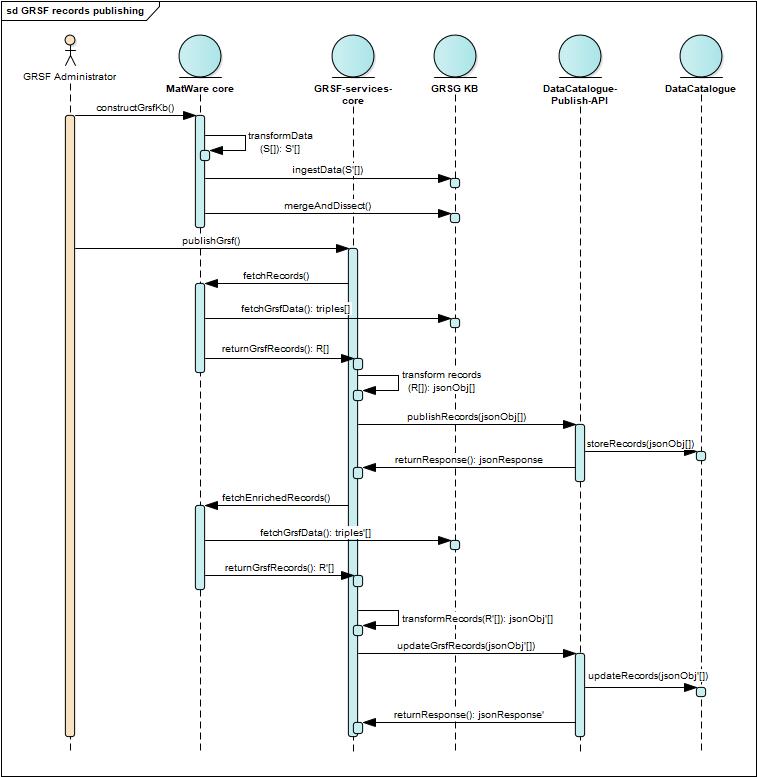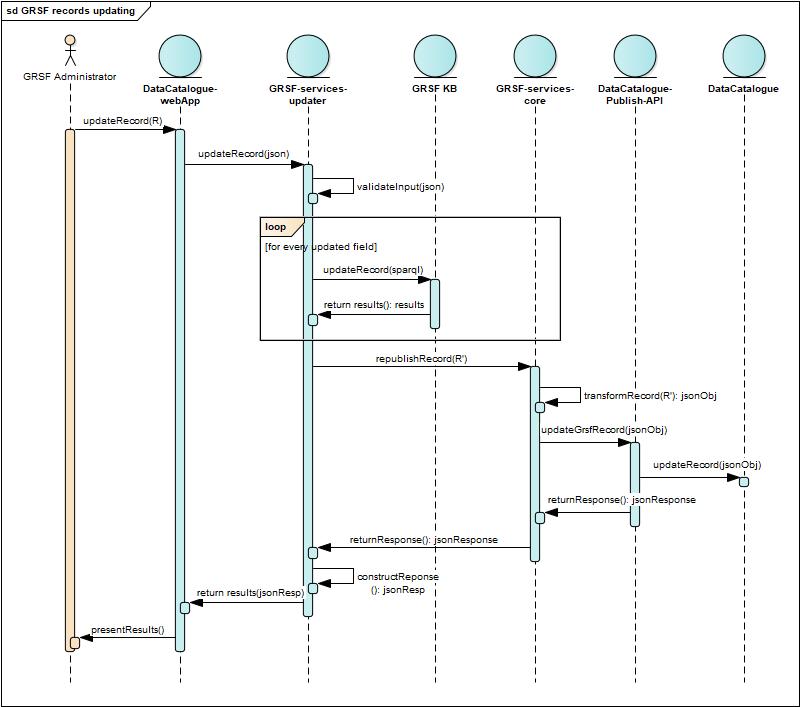GRSF-services
GRSF-services
In this page we describe the components that are responsible for interacting with the gCube infrastructure for performing various activities about GRSF records. GRSF records are handled as dataset resources and are stored in the data catalogue. The following image depicts a high level view of the architecture of components that are exploited for constructing the GRSF KB, publishing GRSF records and updating them. In the sequel we will focus and describe the components grsf-services-core and grsf-services-updater.
grsf-services-core
This component is responsible for retrieving individual records from the GRSF KB and publish them in the GRSF data catalogue. For this reason it uses the particular service (which is described at GCube_Data_Catalogue_for_GRSF). Since the service is accepting incoming records (either for stocks or fisheries) as JSON objects, the main functionality of the grsf-services-core component is to act a a bridge between the GRSF KB and the GRSF data catalogue. The corresponding steps for publishing a set of records is described below (and in the corresponding part of the sequence diagram).
- The grsf-services-core component fetches all the GRSF records and their corresponding information from the GRSF KB. Since the GRSF KB is a semantic warehouse, its contents are stored as a set of RDF triples; therefore in order to fetch them a particular SPARQL query has to be formulated and submitted to the GRSF KB.
- After fetching all the GRSF records (in terms of RDF triples), they have to be transformed so that they can be published through the publishing service of the GRSF data catalogue. The services accepts JSON object, therefore the RDF triples are transformed accordingly with respect to the expected metadata (which are described here).
- The grsf-services-core component publishes the transformed JSON objects and retrieves the results.
The component is being delivered as a software library. It is being triggered from MatWare after the construction of the GRSF KB.
grsf-services-updater
This component is responsible for updating the status of a record, when the users requires so. More specifically the component is delivered as a service, that accepts incoming requests containing the record that will be updated, with its accompanying information (the new status, a narrative text describing the status update). Once a request has been received the service will update the contents in the GRSF KB, and return a response message information the caller for the results. The communication messages for the service are formulated JSON objects. The service allows updating the following fields of a record:
- Updates the status of a record (available statuses: pending, approved, rejected, hidden, archived).
- Updates the short name of a record.
- Updates the tracability flag of a record.
- Updates the list of connected exploiting resources.
- Defines alternative merging operations with similar records.
Check service availability
In order to check that the service is up and running you can use the following url
[GRSF_SERVICES-CORE BASE_URL]/grsf-services-updater
This will show a landing page with instructions for using the service indicating that the service is up and running.
Service endpoints
The service exposes the following endpoints:
- updater: allows updating a record.
- revert: allows reverting the proposed merging of records.
- info: shows detailed information about the services (triplestore and publisher information).
Updater endpoint
It is a POST service that allows updating various infomation about a record.
Service Request
The service accepts as input JSON objects. Some of the fields in the object are mandatory while others are optional. The following table lists the fields of the JSON objects.
| Name | Api Name (JSON) | Mandatory/Optional | Description |
|---|---|---|---|
| Catalogue ID | catalog_id | mandatory | the id of the record in the data catalog |
| Knowledge Base UUID | knowledge_base_id | mandatory | the uuid of the record in the GRSF knowledge base |
| Old Status | old_status | mandatory | the old status of the record. The accepted values are: [approved, rejected, pending, hidden, archived] |
| New Status | new_status | mandatory | the new status of the record. The accepted values are: [approved, rejected, pending, hidden, archived] |
| Old Short Name | short_name_old | mandatory | the old short name of the record. |
| New Short Name | short_name_new | mandatory | the new short name of the record. |
| New value for traceability flag | traceability_flag | mandatory | the updated value for traceability flag |
| Administrator name | administrator_name | optional | The name of the administrator performing the change |
| Annotation message | annotation_msg | optional | a short narrative text used for justifying the status change |
| Similar records | similar_records["knowledge_base_id":"...", "merge":false/true] | optional | a list of similar records with a merge flag indicating whether they should be merged or not |
| Connections | connections["source_knowledge_base_id":"...","dest_knowledge_base_id":"...", "remove":false/true] | optional | a list of connections that refer to the exploited resources of the record. The resources that are added here will be added in a list with title connections in the catalog. If there are exploited resources (in the KB) and they are not included in the connections list then they will remain as potential exploiting resources. If remove flag is set to true for a record then it will be totally removed (from connections and exploiting resources), |
An indicative example of a JSON object that can be used as input is the following.
{ "catalog_id": "catalog_id_123", "knowledge_base_id": "3f7b6750-1775-3a2f-a4db-069cbaf4b086", "old_status": "pending", "new_status": "pending", "annotation_message": "", "short_name_old": "Pharaoh cuttlefish - India", "short_name_new": "Pharaoh cuttlefish - India", "traceability_flag": true, "administrator_name": "Yannis Marketakis", "similar_grsf_records": [{ "knowledge_base_id": "9ff63706-ae9e-30e6-8498-425c3274e97e", "merge": false }, { "knowledge_base_id": "9f5c69c4-b262-31c5-abf1-15a9f1c6622b", "merge": false }], "connections": [{ "source_knowledge_base_id": "3f7b6750-1775-3a2f-a4db-069cbaf4b086", "dest_knowledge_base_id": "e63f87ab-c00a-3a1e-a852-156667ee8049", "remove" : false }, { "source_knowledge_base_id": "3f7b6750-1775-3a2f-a4db-069cbaf4b086", "dest_knowledge_base_id": "491323fc-3cdf-36ab-8c8c-7c6f4262b91c", "remove" : true, } ] }
Service Response
The service returns the response as a JSON object (similar to the input). The following table shows the fields of the object that are returned as a response.
| Name | Api Name (JSON) | Description |
|---|---|---|
| Catalogue ID | catalog_id | the id of the record in the data catalog |
| Knowledge Base UUID | knowledge_base_id | the id of the record in the GRSF knowledge base |
| New Status | new_status | the updated status of the record. |
| New Short name | short_name_new | the updated short name of the record. |
| Update Result | update_result | the result of the update process |
| Error message | error_message | contains the message describing the fault/error that has occurred. If no error emerged then this field is empty. |
An indicative example of a JSON object that can be used as input is the following.
{ "catalog_id": "d290f1ee-6c54-4b01-90e6-d701748f0851", "knowledge_base_id": "15296975-54f5-37f5-8033-84cf7d09c3f5", "new_status": "approved", "short_name_new": "Thunnus albacares North-East Pacific", "update_result": true, "error_message": null }
Apart from returned JSON the service uses HTTP codes for indicating whether the request has been processed successfully or not. More specifically the following HTTP codes are returned:
- 200: it is returned if the request has been processed successfully, and the record has been updated
- 400: it is returned if any of the given parameters that are mandatory is missing or contains incorrect values (i.e. a wrong status value)
- 404: it is returned if the record to be updated does not exist (i.e. cannot find the record ID in the GRSF KB)
- 500: it is returned for any error that might occur when updating the records in the GRSF KB
Revert endpoint
It is a POST service that allows reverting a request for merging records
Service Request
The service accepts as input JSON objects. Some of the fields in the object are mandatory while others are optional. The following table lists the fields of the JSON objects.
| Name | Api Name (JSON) | Mandatory/Optional | Description |
|---|---|---|---|
| Knowledge Base UUID | knowledge_base_id | mandatory | the uuid of the record in the GRSF knowledge base that initiated the merging event (the record that was updated when merging with other similar records was decided), |
| Administrator name | administrator_name | optional | The name of the administrator performing the change |
An indicative example of a JSON object that can be used as input is the following.
{ "knowledge_base_id": "3f7b6750-1775-3a2f-a4db-069cbaf4b086", "administrator_name": "Yannis Marketakis", }
Service Response
The service returns the response as a JSON object (similar to the input). The following table shows the fields of the object that are returned as a response.
| Name | Api Name (JSON) | Description |
|---|---|---|
| Knowledge Base UUID | knowledge_base_id | the id of the record in the GRSF knowledge base |
| Update Result | update_result | the result of the update process |
| Error message | error_message | contains the message describing the fault/error that has occurred. If no error emerged then this field is empty. |
An indicative example of a JSON object that can be used as input is the following.
{ "knowledge_base_id": "15296975-54f5-37f5-8033-84cf7d09c3f5", "update_result": false, "error_message": "There knowledge base UUID is missing" }
Apart from returned JSON the service uses HTTP codes for indicating whether the request has been processed successfully or not. More specifically the following HTTP codes are returned:
- 200: it is returned if the request has been processed successfully, and the change was reverted
- 400: it is returned if any of the given parameters that are mandatory is missing or contains incorrect values
- 404: it is returned if the record to be reverted does not exist
- 500: it is returned for any error that might occur while reverting merge events in the GRSF KB
Info endpoint
It is an GET service that reports the following information about the service endpoint:
- service name and version
- triplestore used information (host and port)
- publisher API information (host and catalog scope)
Service Response
The service returns the response as a JSON object (similar to the input). The following table shows the fields of the object that are returned as a response.
| Name | Api Name (JSON) | Description |
|---|---|---|
| Service Name | name | the name of the service (i.e. grsf-services-updater) |
| Service Version | version | the vesion of the service (i.e. 1.2.0) |
| Documentation | documentation | points to the documentation page of the service (i.e. this page or documentation in swagger) |
| Triplestore Information | triplestore: {"host":"...", "port":...} | contains information about the triplestore that is used |
| Catalog Information | catalog_info: {"host":"...", "scope":...} | contains information about the publisher API used and scope of the catalog |
An indicative example of a JSON object that can be used as input is the following.
{ "name": "grsf-services-updater", "version": "1.2.0", "documentation": "http://app.swaggerhub/apis/...", "triplestore": { "host": "http://example.com/", "port": 1234 }, "catalog_info": { "host": "http://example.com/", "scope": "ADMIN" } }
Apart from returned JSON the service uses HTTP codes for indicating whether the request has been processed successfully or not. More specifically the following HTTP codes are returned:
- 200: it is returned if the request has been processed successfully, and the information are shown
Service Documentation
The detailed documentation of the service can be found in Swagger https://app.swaggerhub.com/apis/ymark/grsf-services-updater


